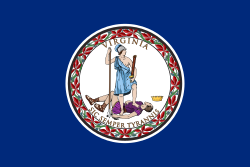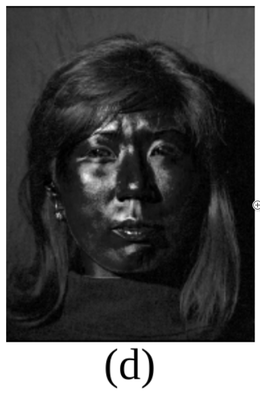Laws against synthesis and other related crimes
Laws and their application
Law on synthetic filth in Virginia


Since July 1 2019[1] w:Virginia w:has criminalized the sale and dissemination of unauthorized synthetic pornography, but not the manufacture.[2], as § 18.2-386.2 titled 'Unlawful dissemination or sale of images of another; penalty.' became part of the w:Code of Virginia.
Code of Virginia (TOC) » Title 18.2. Crimes and Offenses Generally » Chapter 8. Crimes Involving Morals and Decency » Article 5. Obscenity and Related Offenses » § 18.2-386.2. Unlawful dissemination or sale of images of another; penalty
The law § 18.2-386.2. Unlawful dissemination or sale of images of another; penalty. of Virginia is as follows:
A. Any w:person who, with the w:intent to w:coerce, w:harass, or w:intimidate, w:maliciously w:disseminates or w:sells any videographic or still image created by any means whatsoever that w:depicts another person who is totally w:nude, or in a state of undress so as to expose the w:genitals, pubic area, w:buttocks, or female w:breast, where such person knows or has reason to know that he is not w:licensed or w:authorized to disseminate or sell such w:videographic or w:still image is w:guilty of a Class 1 w:misdemeanor. For purposes of this subsection, "another person" includes a person whose image was used in creating, adapting, or modifying a videographic or still image with the intent to depict an actual person and who is recognizable as an actual person by the person's w:face, w:likeness, or other distinguishing characteristic.
B. If a person uses w:services of an w:Internet service provider, an electronic mail service provider, or any other information service, system, or access software provider that provides or enables computer access by multiple users to a computer server in committing acts prohibited under this section, such provider shall not be held responsible for violating this section for content provided by another person.
C. Venue for a prosecution under this section may lie in the w:jurisdiction where the unlawful act occurs or where any videographic or still image created by any means whatsoever is produced, reproduced, found, stored, received, or possessed in violation of this section.
D. The provisions of this section shall not preclude prosecution under any other w:statute.[2]
The identical bills were House Bill 2678 presented by w:Delegate w:Marcus Simon to the w:Virginia House of Delegates on January 14 2019 and three day later an identical Senate bill 1736 was introduced to the w:Senate of Virginia by Senator w:Adam Ebbin.
Law on synthetic filth in Texas

Since September 1 2019 w:Texas senate bill SB 751 w:amendments to the election code came into effect, giving w:candidates in w:elections a 30-day protection period to the elections during which making and distributing digital look-alikes or synthetic fakes of the candidates is an offense. The law text defines the subject of the law as "a video, created with the intent to deceive, that appears to depict a real person performing an action that did not occur in reality"[3]
Law on synthetic filth in California


January 1 2020 [4] the w:California w:US state law "AB-602 Depiction of individual using digital or electronic technology: sexually explicit material: cause of action." came into effect banning the manufacturing and w:digital distribution of synthetic pornography without the w:consent of the people depicted. AB-602 provides victims of synthetic pornography with w:injunctive relief and poses legal threats of w:statutory and w:punitive damages on w:criminals making or distributing synthetic pornography without consent. The bill AB-602 was signed into law by California w:Governor w:Gavin Newsom on October 3 2019 and was authored by w:California State Assembly member w:Marc Berman and an identical Senate bill was coauthored by w:California Senator w:Connie Leyva.[5][6] AB602 at trackbill.com
The law of California is as follows:
Law on synthetic filth in New York

In the 2021-2022 w:New York State Senate regular sessions, on 2021-01-14 Senators w:James Skoufis, w:Brian Benjamin and w:Todd Kaminsky of the New York State Senate introduced New York Senate bill S1641 - Establishes the crime of unlawful electronic transmission of sexually explicit visual material and on 2021-03-19 an identical New York Assembly bill A6517 - Establishes the crime of unlawful electronic transmission of sexually explicit visual material was introduced to the w:New York State Assembly by Assembly Member w:Aileen Gunther.[1st seen in 1]
- TITLE OF BILL: An act to amend the penal law, in relation to the creation of the criminal offense of unlawful electronic transmission of sexually explicit visual material
- PURPOSE: The purpose of this bill is to make it unlawful to send sexually explicit material through electronic means unless the material is sent at the
request of, or with the express consent of the recipient.
- SUMMARY OF PROVISIONS: Adds a new section 250.70 to the penal law making it unlawful to knowingly transmit by electronic means visual material that depicts any person engaging in sexual conduct or with a person's intimate parts exposed unless the material is sent at the request of, or with the express consent of the recipient.
- JUSTIFICATION: Currently under New York State law, indecent exposure in person is a crime, but it is not unlawful to send sexually explicit photos to
nonconsenting adult recipients through electronic transmission. With the growing modem age of online dating, many individuals are receiving sexually explicit visual content without their consent from strangers. No person should be forced to view sexually explicit material without their consent.
The bill offers a clear deterrent to those considering sending unsolicited sexual pics and similar inappropriate conduct, and protects the unwilling recipients who currently have no legal recourse for such abuses.
What is illegal in the real world must be illegal in the digital world,and this legislation is a first step in the right direction in adding that accountability.
- LEGISLATIVE HISTORY:
- Senate - 2020 - S5949 Referred to Codes
- Assembly - 2020 - A7801 Referred to Codes
- FISCAL IMPLICATIONS: Minimal
- EFFECTIVE DATE: This act shall take effect on the first of November next succeeding the date on which it shall have become a law.
Law on synthetic filth in China
On January 1 2020 Chinese law requiring that synthetically faked footage should bear a clear notice about its fakeness came into effect. Failure to comply could be considered a w:crime the w:Cyberspace Administration of China (cac.gov.cn) stated on its website. China announced this new law in November 2019.[8] The Chinese government seems to be reserving the right to prosecute both users and w:online video platforms failing to abide by the rules. [9]
Law on synthetic filth in the UK


The UK law does not seem very up-to-date on the issue of synthetic filth.
The independent w:Law Commission (England and Wales) is currently reviewing the law as it applies to taking, making and sharing intimate images without consent. The outcome of the consultation is due to be published later in 2021.[10]
"In 2019, law expert Dr Aislinn O’Connell told w:The Independent that our current laws on image sharing are piecemeal and not fit for purpose. In October 2018 The w:Women and Equalities Committee called on the UK Government to introduce new legislation on image-based sexual abuse in order to criminalise ALL non-consensual creation and distribution of intimate sexual images."[11] This call is for similar laws as California put in place on January 1 2020.
The petition 'Tighten regulation on taking, making and faking explicit images' at Change.org by w:Helen Mort aims to petition the UK govt for proper legislation against synthetic filth. See the mediatheque for a video by Helen Mort on her ordeal of becoming the victim of covert disinformation attacks.
Resources and reporting on law
AI and law in general

Reviews and regulation From the w:Library of Congress:
- 'Regulation of Artificial Intelligence' at loc.gov
- 'Regulation of Artificial Intelligence: Comparative Summary' at loc.gov
- 'Regulation of Artificial Intelligence: International and Regional Approaches' (loc.gov)
- 'Regulation of Artificial Intelligence: The Americas and the Caribbean' (loc.gov)
- 'Regulation of Artificial Intelligence: East/South Asia and the Pacific' (loc.gov)
- 'Regulation of Artificial Intelligence: Europe and Central Asia' loc.gov
- 'Regulation of Artificial Intelligence: Middle East and North Africa' (loc.gov)
- 'Regulation of Artificial Intelligence: Sub-Saharan Africa' (loc.gov)
w:Gibson Dunn & Crutcher (gibsondunn.com) publishes a quarterly legal update on 'Artificial Intelligence and Autonomous Systems'. Gibson Dunn & Crutcher is a global w:law firm, founded in Los Angeles in 1890.
- 'Artificial Intelligence and Autonomous Systems Legal Update' Quarter 4 2018 at Gibson & Dunn
- 'Artificial Intelligence and Autonomous Systems Legal Update Quarter 1 2019'
- 'Artificial Intelligence and Autonomous Systems Legal Update Quarter 2 2019'
- 'Artificial Intelligence and Autonomous Systems Legal Update Quarter 3 2019'
- 'Artificial Intelligence and Autonomous Systems Legal Update Quarter 4 2019'
From Europe

- 'The ethics of artificial intelligence: Issues and initiatives' (.pdf) at europarl.europa.eu, a March 2020 study by the w:European Parliamentary Research Service Starting from page 37 the .pdf lists organizations in the field.
Synthetic filth in the law and media
- 'Deepfakes and Synthetic Media in the Financial System: Assessing Threat Scenarios' at carnegieendowment.org, a 2020-07-08 assessment identifies some types of criminalities that can be made using synthetic human-like fakes.
- 'Deepfakes: False Pornography Is Here and the Law Cannot Protect You', published in 2019 in the Duke Law Journal, a student-run law review.
The countries that have unfortunately banned full face veil
“There are currently 16 nations that have banned the burqa (not to be confused with the hijab), including w:Tunisia,[12] w:Austria, w:Denmark, w:France, w:Belgium, w:Tajikistan, w:Latvia,[13] w:Bulgaria,[14] w:Cameroon, w:Chad, w:Congo-Brazzaville, w:Gabon, w:Netherlands,[15] w:China,[16] w:Morocco, and w:Switzerland.”
Taking into consideration these times of industrial disinformation, it is vicious and uncivilized to have laws banning wearing a the full face veil in public.
Quotes on the current laws and their application
“If no-one who wants to hurt you knows what you look like, so how could someone malevolent make a covert digital look-alike of you?”
Law proposals
Law proposals to ban covert modeling by Juho Kunsola
- Audience: Developed with suitability for national, supranational and UN treaty levels.
- Writing context:
- Written from context of inclusion to criminal codes.
- I'm a Finn so this has been worded to fit in the Chapter 24 of the Criminal Code of Finland (in Finnish at finlex.fi) titled "Offences against privacy, public peace and personal reputation"
- Access the English translations of the Finnish Criminal Code at finlex.fi or go straight to the latest .pdf from 2016. Chapter 24 starts on page 107.
- History: This version is an evolution of a Finnish language original written in 2016.
Existing law in Chapter 24. of the Finnish Criminal Code - "Offences against privacy, public peace and personal reputation" seems to be ineffective against many synthetic human-like fake attack and seems it could be used to frame victims for crimes with digital sound-alikes.
The portions affected by or affecting the synthetic filth situation in bold font:
- Section 1 - Invasion of domestic premises (879/2013)
- Section 1(a) - Harassing communications (879/2013)
- Section 2 - Aggravated invasion of domestic premises (531/2000)
- Section 3 - Invasion of public premises (585/2005)
- Section 4 - Aggravated invasion of public premises (531/2000)
- Section 5 - Eavesdropping (531/2000)
- Section 6 - Illicit observation (531/2000)
- Section 7 - Preparation of eavesdropping or illicit observation (531/2000)
- Section 8 - Dissemination of information violating personal privacy (879/2013)
- Section 8(a) - Aggravated dissemination of information violating personal privacy (879/2013)
- Section 9 - Defamation (879/2013)
- Section 10 - Aggravated defamation (879/2013)
- Section 11 - Definition (531/2000)
- Section 12 - Right to bring charges (879/2013)
- Section 13 - Corporate criminal liability (511/2011)

Original picture by Debevec et al. - Copyright ACM 2000 https://dl.acm.org/citation.cfm?doid=311779.344855
Law proposal to ban covert modeling of human voice
§1 Covert modeling of a human voice
Acquiring such a model of a human's voice, that deceptively resembles some dead or living person's voice model of human voice, possession, purchase, sale, yielding, import and export without the express consent of the target is punishable.
§2 Application of covert voice models
Producing and making available media from a covert voice model is punishable.
§3 Aggravated application of covert voice models
If produced media is for a purpose to
- frame a human target or targets for crimes
- to attempt extortion or
- to defame the target,
the crime should be judged as aggravated.
Law proposal to ban covert modeling of human appearance
Obs. Should banning modeling people's appearance without explicit permission be pursued it must be formulated so that this does not make Adequate Porn Watcher AI (concept) illegal / impossible.
One would assume that collecting permissions to model each porn is not plausible, so the question is that can we ban covert modeling from non-pornographic pictures, while still retaining the ability to model all porn found on the Internet.
§1 Covert modeling of human appearance
Covertly acquiring
- A 3D model
- A 7D bidirectional reflectance distribution function model and similar in results, but technically different model
- A direct-to-2D capable model and similar in results, but a technically different model
without without consent covert modeling of appearance is illegal. Also possession, purchase, sale, yielding, import and export of covert models are punishable.
§2 Aggravated covert modeling of human appearance
If a covert model of the head or the face is attached to a look-alike of a naked body, regardless of whether that is synthetic or of human, the crime should be judged as aggravated.
§3 Application of covert appearance models
Projection and making available media from covert models defined in §1 is punishable.
§4 Aggravated application of covert appearance models
If the projection is portrayed in a nude or sexual situation or used with the intent to frame for a crime or for blackmail, the crime should be judged as aggravated.
References
- ↑ "New state laws go into effect July 1".
- ↑ 2.0 2.1 "§ 18.2-386.2. Unlawful dissemination or sale of images of another; penalty". w:Virginia. Retrieved 2021-01-23.
- ↑
"Relating to the creation of a criminal offense for fabricating a deceptive video with intent to influence the outcome of an election". w:Texas. 2019-06-14. Retrieved 2021-01-23.
In this section, "deep fake video" means a video, created with the intent to deceive, that appears to depict a real person performing an action that did not occur in reality
- ↑ Johnson, R.J. (2019-12-30). "Here Are the New California Laws Going Into Effect in 2020". KFI. iHeartMedia. Retrieved 2021-01-23.
- ↑ "AB 602 - California Assembly Bill 2019-2020 Regular Session - Depiction of individual using digital or electronic technology: sexually explicit material: cause of action". openstates.org. openstates.org. Retrieved 2021-03-24.
- ↑ Mihalcik, Carrie (2019-10-04). "California laws seek to crack down on deepfakes in politics and porn". w:cnet.com. w:CNET. Retrieved 2021-01-23.
- ↑ Berman, Marc; Leyva, Connie (2019), "AB-602 Depiction of individual using digital or electronic technology: sexually explicit material: cause of action.", w:California
- ↑ "China seeks to root out fake news and deepfakes with new online content rules". w:Reuters.com. w:Reuters. 2019-11-29. Retrieved 2021-01-23.
- ↑ Statt, Nick (2019-11-29). "China makes it a criminal offense to publish deepfakes or fake news without disclosure". w:The Verge. Retrieved 2021-01-23.
- ↑
Royle, Sara (2021-01-05). "'Deepfake porn images still give me nightmares'". w:BBC Online. w:BBC. Retrieved 2021-01-31.
She alerted the police to the images but was told that no action could be taken. Dr Aislinn O'Connell, a lecturer in law at Royal Holloway University of London, explained that Helen's case fell outside the current law.
- ↑
Mort, Helen (2020). "Change.org petition: 'Tighten regulation on taking, making and faking explicit images'". w:Change.org. w:Change.org. Retrieved 2021-01-31.
Unlike other forms of revenge porn, creating pictures or videos like this is not yet illegal in the UK, though it is in some places in the US. The police were unable to help me.
- ↑ "Tunisian PM bans wearing of niqab in public institutions". Reuters. 5 July 2019. Retrieved 2021-03-13.
- ↑ "A European government has banned Islamic face veils despite them being worn by just three women". 21 April 2016. Retrieved 2021-03-13.
- ↑ Bulgaria the latest European country to ban the burqa and [niqab in public places, Smh.com.au: accessed 5 December 2016.
- ↑ Halasz, Stephanie; McKenzie, Sheena (27 June 2018). "The Netherlands introduces burqa ban in some public spaces" (27 June 2018). CNN. CNN. Retrieved 2021-03-13.
- ↑ Phillips, Tom (13 January 2015). "China bans burqa in capital of Muslim region of Xinjiang". The Telegraph (13 January 2015). The Telegraph. Retrieved 2021-03-13.
Cite error: <ref> tags exist for a group named "1st seen in", but no corresponding <references group="1st seen in"/> tag was found